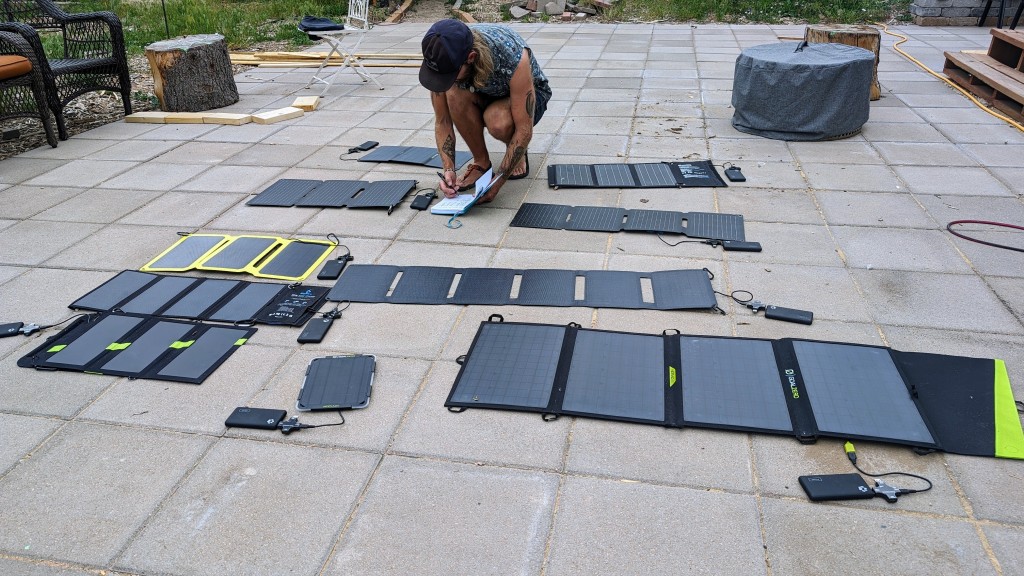Hiking is a fun way to enjoy nature. But, keeping devices charged can be tough. This is where solar power banks come in handy. They use the sun to charge your gadgets. Easy and green!

Credit: www.outdoorgearlab.com
Why You Need a Solar Power Bank for Hiking
Hiking in the wild is exciting. But, phones and cameras need power. A solar power bank is a great solution. It charges with sunlight. So, no need to worry about empty batteries.
Solar power banks are light. This makes them easy to carry. They are also durable. Perfect for outdoor adventures.
What To Look For In A Solar Power Bank
Not all solar power banks are the same. You need to choose wisely.
- Capacity: How much power can it hold? More capacity means more charges.
- Size and Weight: Is it easy to carry? Lightweight is best for hiking.
- Durability: Can it handle rough use? Waterproof and shockproof features are good.
- Charging Speed: How fast can it charge your device? Faster is better.
- Number of Ports: How many devices can you charge at once? More ports mean charging more devices.
Top Solar Power Banks for Hiking
Let’s explore some great options.
1. Bigblue 28w Solar Charger
This is a strong choice for hikers. It has a high capacity. It can charge a phone many times. It is also waterproof. This means it’s safe in the rain.
| Capacity | 28 Watts |
|---|---|
| Weight | 1.3 pounds |
| Ports | 3 USB ports |
| Durability | Waterproof |
This power bank is easy to use. Just unfold and place in sunlight. It starts charging right away. Great for long hikes.
2. Anker 21w Dual Usb Solar Charger
Anker is a well-known brand. This solar charger is popular. It is compact and light. Perfect for hiking trips.
| Capacity | 21 Watts |
|---|---|
| Weight | 0.8 pounds |
| Ports | 2 USB ports |
| Durability | Weather-resistant |
This charger has fast charging. It works even in low light. Handy for cloudy days.
3. Goal Zero Nomad 7 Plus Solar Panel
This is a powerful solar panel. It is small yet efficient. Ideal for outdoor lovers.
| Capacity | 7 Watts |
|---|---|
| Weight | 0.8 pounds |
| Ports | 1 USB port |
| Durability | Weatherproof |
It has a smart feature. It stops charging when the device is full. This saves power. Also, it protects your device.
4. Ravpower Solar Charger 16w
This is a reliable choice. It is very light. Perfect for backpacking.
| Capacity | 16 Watts |
|---|---|
| Weight | 0.7 pounds |
| Ports | 2 USB ports |
| Durability | Weather-resistant |
This charger has a smart IC chip. It detects your device. This gives the best charging speed.
5. X-dragon 20w Sunpower Solar Charger
X-DRAGON offers this great charger. It is efficient and fast. It is perfect for adventurous hikes.
| Capacity | 20 Watts |
|---|---|
| Weight | 1 pound |
| Ports | 2 USB ports |
| Durability | Weather-resistant |
This charger has high conversion efficiency. It can charge quickly. Even on partly cloudy days.
How to Use a Solar Power Bank
Using a solar power bank is easy. First, make sure the solar panel faces the sun. This will help it charge well.
Connect your device to the power bank. Use the USB cable. The device will start charging. Simple!
Remember to keep it clean. Dust can block sunlight. Wipe it with a soft cloth.
Caring for Your Solar Power Bank
Take care of your solar power bank. It will last longer.
- Keep it away from water. Unless it’s waterproof.
- Do not drop it. It may break.
- Store in a cool place. Heat can damage it.
Always follow the instructions. This will keep it working well.
Frequently Asked Questions
What Features Should A Solar Power Bank Have For Hiking?
A good solar power bank should be lightweight, durable, and have fast charging capabilities. Look for water resistance and reliable battery capacity.
How Long Does A Solar Power Bank Take To Charge?
Charging time varies. It depends on the sunlight and power bank size. Usually, solar charging takes several hours.
Is A Solar Power Bank Effective In Cloudy Weather?
Yes, but efficiency drops. Solar panels can still generate power in cloudy conditions, though slower than in direct sunlight.
Conclusion
Solar power banks are a great tool for hikers. They keep your devices charged. No need for a wall socket.
Choose a power bank that suits you. Check the capacity, weight, and durability. Enjoy your hike with peace of mind.
Remember, the sun is a free source of power. Use it wisely!

